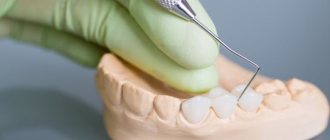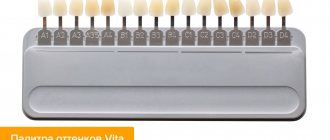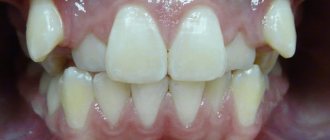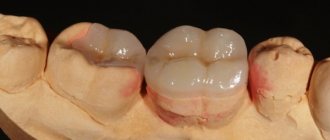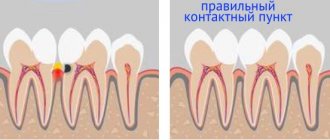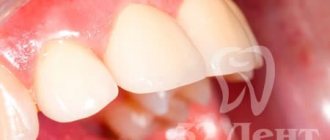A stump inlay is a microprosthesis, which is a tooth stump made of metal, ceramics or zirconium dioxide. It is used when there is significant destruction of the crown part of the tooth and the root is intact. The prosthesis fills the resulting void and creates a support on which an artificial crown is placed. Before installing the inlay, the tooth must be depulped.
A tooth stump inlay is a reliable prosthetic method. With a well-sealed canal and the choice of high-quality materials (for example, gold), it lasts up to 15–20 years.
At the Mitino Dental Center you can get advice from a qualified orthopedic dentist, as well as perform any type of dental prosthetics.
In what cases is the installation of a stump tab indicated?
If a tooth is destroyed by 70% or more, its restoration with filling material using a pin becomes impractical - such a design cannot withstand loads. In this case, there is a threat of fracture of the root itself. This leads to tooth extraction, which means prosthetics become more complicated. Therefore, if there is practically nothing left except the root, the best option would be to install a stump tab. At the same time, the edge of the tooth must still protrude above the gum, on which it can be fixed, otherwise it will be impossible to install an artificial stump.
Important! You can use a stump tab only if there is a healthy root.
The inlay is also used if the tooth is being prepared as a support tooth for a bridge or splinting structure - this increases their reliability.
It is possible to use this technique for pathological tooth wear, as well as anomalies in the development of anterior teeth in adults that cannot be eliminated by orthodontic methods.
Indications and contraindications.
Installing a ceramic inlay requires two visits to the dentist. The first, in which the doctor examines the patient's oral cavity, evaluates the possibility of restoration and takes an impression, from which the technician will make a plaster model for the restoration. The tooth is first restored on a model and then the inlay is installed on the tooth. At the first appointment, the doctor explains in detail how the restoration will be carried out, what procedures need to be done, and what the cost of restoration will be for a particular patient. The second visit is accompanied by fitting and evaluation of the technician’s work - how well the inlay matches the color, transparency and shape of the living tooth, how it interacts with neighboring teeth, and whether it causes discomfort to the patient. After this, the tab is glued to the tooth. It should be understood that a ceramic inlay is installed only according to a doctor’s indications. Quite often, if possible, a crown is not placed, and restoration is carried out using inlays. Among the many advantages of a ceramic inlay, it is worth mentioning that plaque does not settle on it, over time the inlay does not fade or change color, in addition, the inlay does not irritate the soft tissues of the oral cavity. Ceramic inlays are ideally combined with tooth enamel and do not contain micropores, which guarantees the absence of detachments from the walls. After restoration of the front teeth with ceramic inlays, the teeth look natural. The main indications for installing a ceramic inlay include significant damage to the tooth when restoration with a filling is impossible. If the tooth is partially preserved, an inlay can preserve the natural tooth. If we talk about comfort, it is worth noting that the inlays do not require additional care; it is necessary to maintain regular personal hygiene, conduct preventive examinations at the dentist and promptly treat any problems that arise. As for contraindications to the installation of a ceramic inlay, it is worth highlighting the presence of such factors in the patient as a shallow cavity depth, bruxism, insufficient personal hygiene, high caries activity, the presence of steep bevels of the cusps, and an approximal cavity extending deep into the dentin. In addition, it should be understood that if a wisdom tooth requires restoration, installing an inlay on it is impractical, since such a tooth does not bear the chewing load. When a wisdom tooth is destroyed, its removal is most often indicated.
Types of stump inlays
The prosthesis consists of intracanal (root) and supracanal (visible) parts.
The root part looks like a pin (or pins). This end of the stump is attached to the canal using glass ionomer cement or composite material.
The supra-canal part has the shape of a ground tooth. A crown made of metal-ceramic, ceramic or zirconium dioxide is placed on it.
By design, tabs are divided into types:
- Non-separable. Performed by solid casting or milling (CAD/CAM). Used for prosthetics of single- or double-channel teeth.
- Collapsible. It consists of several parts, which are individually placed in the channels. They are used when replacing three- and four-channel units, as well as when channels are tortuosity. This design best matches the anatomy of the tooth, but it cannot be removed, so it is guaranteed for life.
Materials
The core inlay for the crown is made:
- made of metals;
- ceramics;
- zirconium dioxide;
- metal ceramics.
Metal tabs
Metal stumps are made from dental metals: chromium-cobalt alloy, precious metals and their alloys.
These are very reliable designs that can last for years. Gold ones are the most durable. The precious metal does not corrode, is durable and relatively soft and can last up to 20 years. However, metal inlays have a drawback - they are unaesthetic and therefore not suitable for ceramic crowns.
All-ceramic
Made from pressed ceramics. They have excellent aesthetic characteristics and are indistinguishable from natural enamel. However, they are relatively fragile, so they are installed in the smile area, where “beauty” is required and the chewing load is lower.
Zirconium
Zirconium dioxide inlays are a type of all-ceramic inlays, but do not have their disadvantages. They are flawless in terms of appearance - their color and transparency are identical to human enamel. At the same time, the strength of zirconium is not inferior to steel, so it can be safely placed on both chewing and frontal units.
Metal-ceramic
Made of metal with a ceramic layer applied on top. Nowadays they are rarely installed, as they often fall out due to different rates of thermal expansion of metal and ceramics.
Stump tab: price
The most budget option is made of base metal. The most expensive is made of zirconium dioxide. Your doctor will help you choose the best option based on price and functionality.
Which tab is better to choose?
It depends on the following conditions:
- what unit is being prosthetized;
- what material will the crown be made of?
- What budget does the patient expect?
Under a ceramic or zirconium crown, you need to install a stump made of the same material. This is dictated by both aesthetic requirements and the laws of physics. Zirconium dioxide and ceramic have a transparency identical to enamel, which means that the metal will show through the crown, giving the teeth a bluish tint. Also, due to the difference in the properties of metal and ceramics, problems with the stability of the entire structure may arise.
The ceramic prosthesis looks perfect. However, ceramics, and especially zirconium dioxide, are expensive. If the entire “core inlay + artificial crown” structure is made from this material, prosthetics will require significant investments. Therefore, most often, patients are recommended this type of prosthetics only in the smile area. But if your budget is not limited, the ideal option is an inlay and a crown made of zirconium dioxide for the front and chewing teeth.
If you choose a metal-ceramic crown, a metal core will fit it. This design will look good in the smile area, and can also withstand chewing loads, which means it is universal. The price segment of such a prosthesis is average. If you put a gold tab on your chewing teeth, it will last a long time, but this will lead to a significant increase in the cost of the entire prosthesis.
But if you don’t have a lot of money and you need to restore a molar, you can safely install a dental metal inlay and cover it with a metal crown. No one will see your tooth, and the design will correspond to the saying “cheap, reliable and practical.”
Ceramic tooth inlay: advantages and disadvantages of products
Currently, ceramic onlays are the most common method of restoring incisors, molars or premolars; they are recognized as reliable and durable. Unlike composite fillings, they are not made in the patient’s mouth, but in isolation, in a dental laboratory (using impressions). This allows you to create an anatomically correct tooth shape with increased accuracy. This factor is very important for the area of contact with the adjacent incisor, molar or premolar. The use of ceramic inlays makes it possible not to resort to crowns if the root bases of the teeth are intact. The main advantages of the products include:
- high aesthetic qualities. Ceramic onlays are no different from natural molars or premolars. The material fully matches their visual characteristics. Only a specialist can notice the difference upon careful close examination;
- durability (compared to a conventional filling). If you follow all the recommendations prescribed by your doctor, the orthopedic design can last more than 10 years. For comparison, a regular filling lasts about 3-4 years;
- no changes in appearance. Ceramics do not darken over the course of a year, so the original color remains intact for the entire duration of wear. It is completely resistant to dyes and other external factors;
- no shrinkage and polymerization after fastening. The main factor influencing the development of secondary carious lesions is pathogenic microorganisms that enter the gap between dentin and filling material. It occurs as a result of shrinkage of the filling. Under the influence of ultraviolet radiation, the filling significantly decreases in volume and sags. e max structures retain their dimensions and do not change during the manufacturing and installation process. Their grinding occurs at the same time as the tooth tissues;
- complete safety. The material does not have a negative effect on the human body and does not provoke the development of allergic reactions;
- high strength. Unlike conventional fillings (light, chemical), the inlay is more securely fixed and is characterized by increased resistance to mechanical and thermal stress.
The emax ceramic inlay has no significant disadvantages. Some are confused by the time spent on manufacturing and installing orthopedic structures, which, unlike conventional fillings, require several visits to the dentist's office. Relative disadvantages include the high price (compared to inlays made of other metals). It is worth noting that their quality, aesthetics and long service life justify their relatively high cost.
Installation steps
This type of prosthetics takes place in two stages - clinical and orthopedic. Orthopedic, in turn, is performed in stages.
Prosthetics begins with a consultation with an orthopedist. He decides on the possibility of using this method and agrees with the patient on all the details of the restoration.
Clinical stage
Performed in the dentist's office. A “living” tooth must be depulped and the canals filled. If the pulp is no longer present, an x-ray of the tooth is taken and the quality of the filling is checked. If it is bad, the channels are re-treated. This is a very important stage - the quality of canal filling determines how long your prosthesis will last.
Orthopedic stage
Takes place in the office of an orthopedic dentist:
- Using a drill, the doctor will unseal the upper part of the canal, into which the root part of the tab will go. A bed is created to accommodate it.
- An impression is taken of the patient's jaws.
- The impression is transferred to a technical laboratory, where dental technicians model and cast the prosthesis (or parts of it in the case of a collapsible design). If the innovative CAD/CAM method is used, the impression is scanned with a special device, the program creates a 3D model of the inlay, and then sends it to a milling machine, which turns it out.
- The orthopedist performs the final adjustment of the stump “on the patient.” Then it is secured in the canal with glass ionomer cement or composite material.
Then comes the next stage - installation of the crown. It follows the same algorithm: taking impressions, manufacturing and fitting.
How is the tab made?
At the MediLine dental clinic, a high-tech CEREC hardware complex is used to make inlays. It allows you to scan the damaged cavity, model the inlay individually for each patient and, based on the prototype, turn it out of a single block of ceramics. Next, the tab is fired in a special oven and only then fixed to the tooth. Everything ingenious is simple!
Pros and cons of stump inlays
A significant advantage of these microprostheses is their high reliability and preservation of the anatomical structure of the tooth. The root is intact, so the dental unit receives full load when chewing. This means that the bone tissue of the jaw does not degrade, and normal bite and diction are maintained.
The installation procedure is minimally invasive and usually easy to tolerate.
Why should you contact TriDental dentistry?
The most painful process during prosthetics is the grinding of bone tissue; the patient feels discomfort, but not pain, since the process is carried out under local anesthesia. First, the dentist cleans the oral cavity and removes plaque and tartar, after which an x-ray is taken, impressions are taken, and an antiseptic treatment is performed.
Many years of experience and equipping the clinic with modern European equipment allowed us to select the most effective and painless treatment methods. Our advantages:
- low prices for ceramic tooth inlays;
- use of high-quality anesthesia;
- individual approach to each patient;
- All services are guaranteed!
To clarify details or make an appointment for the installation of ceramic crowns and inlays, you can always contact our employees for help by phone or through the feedback form on the official website.
